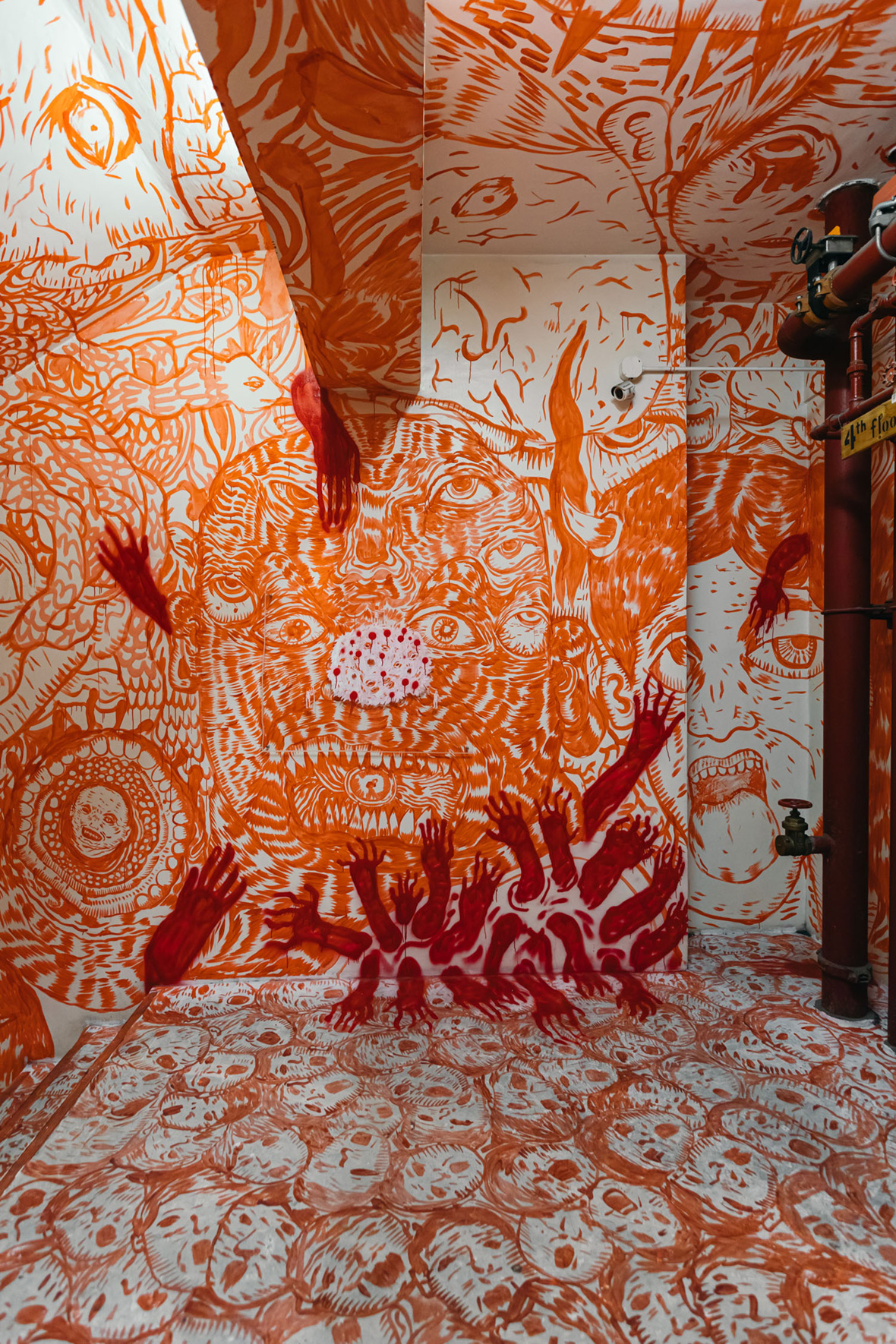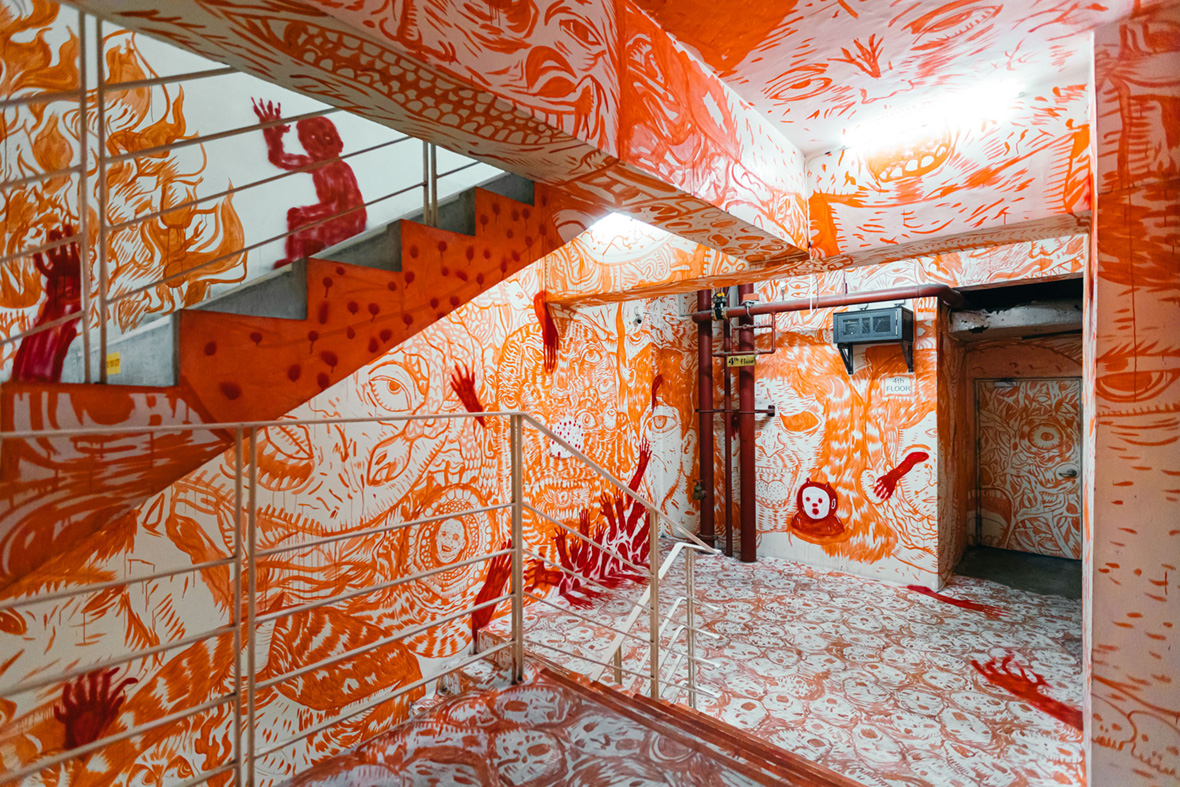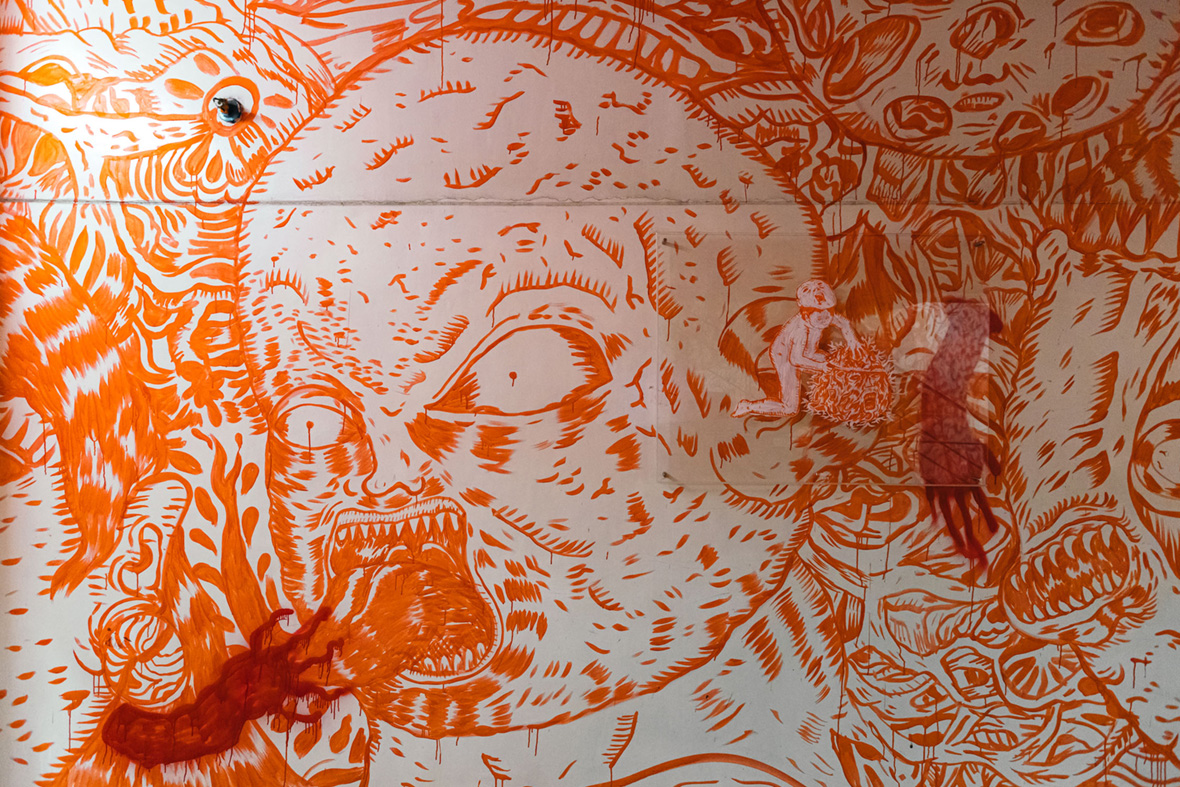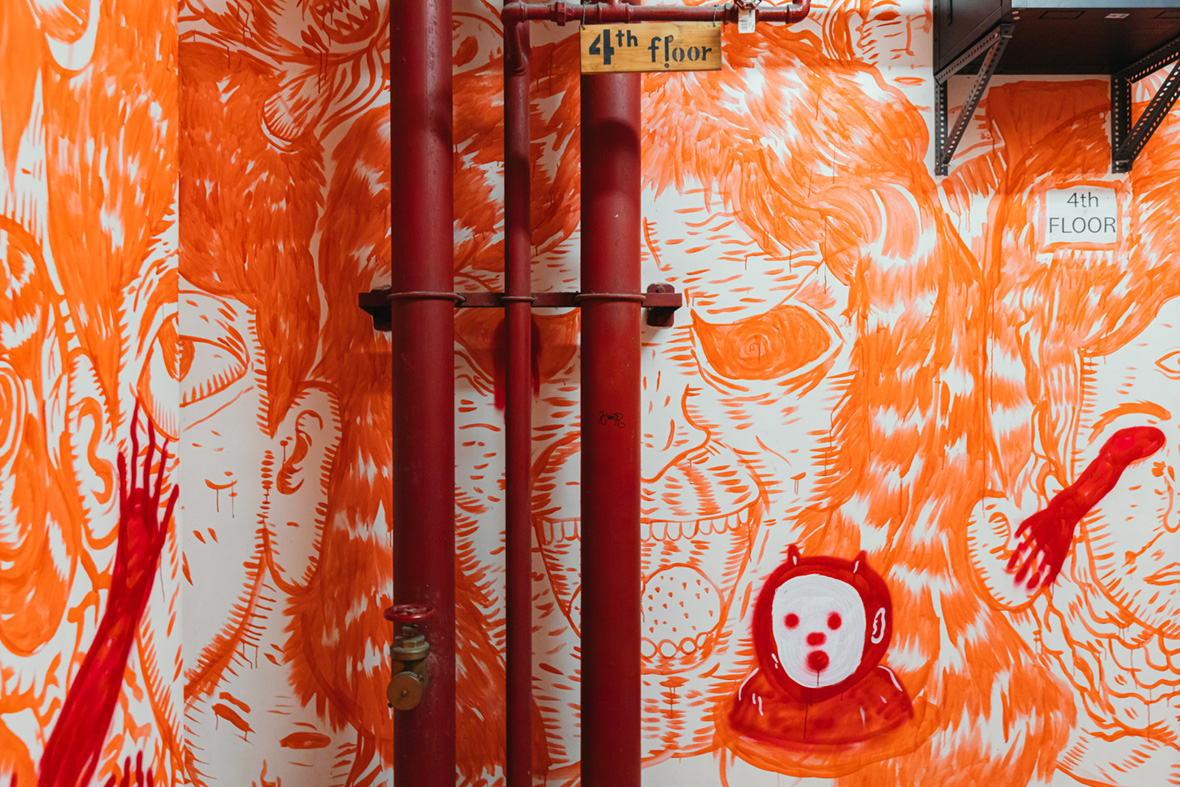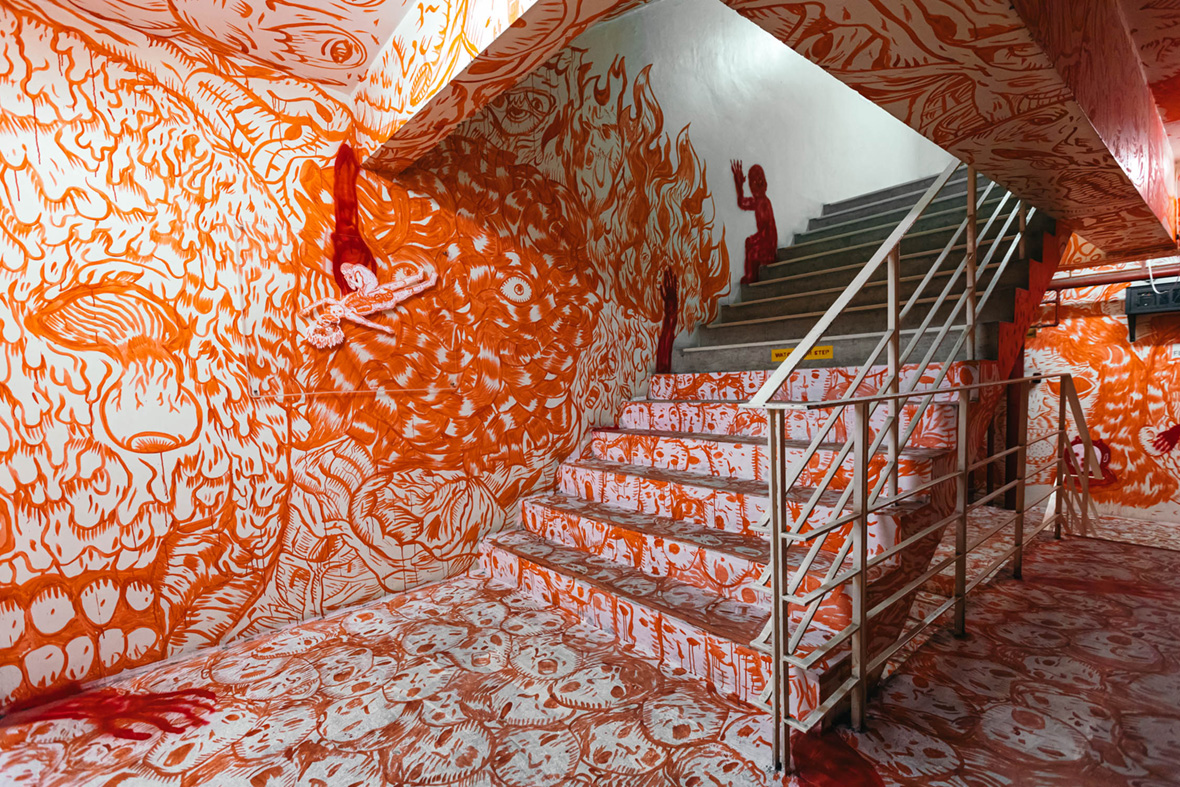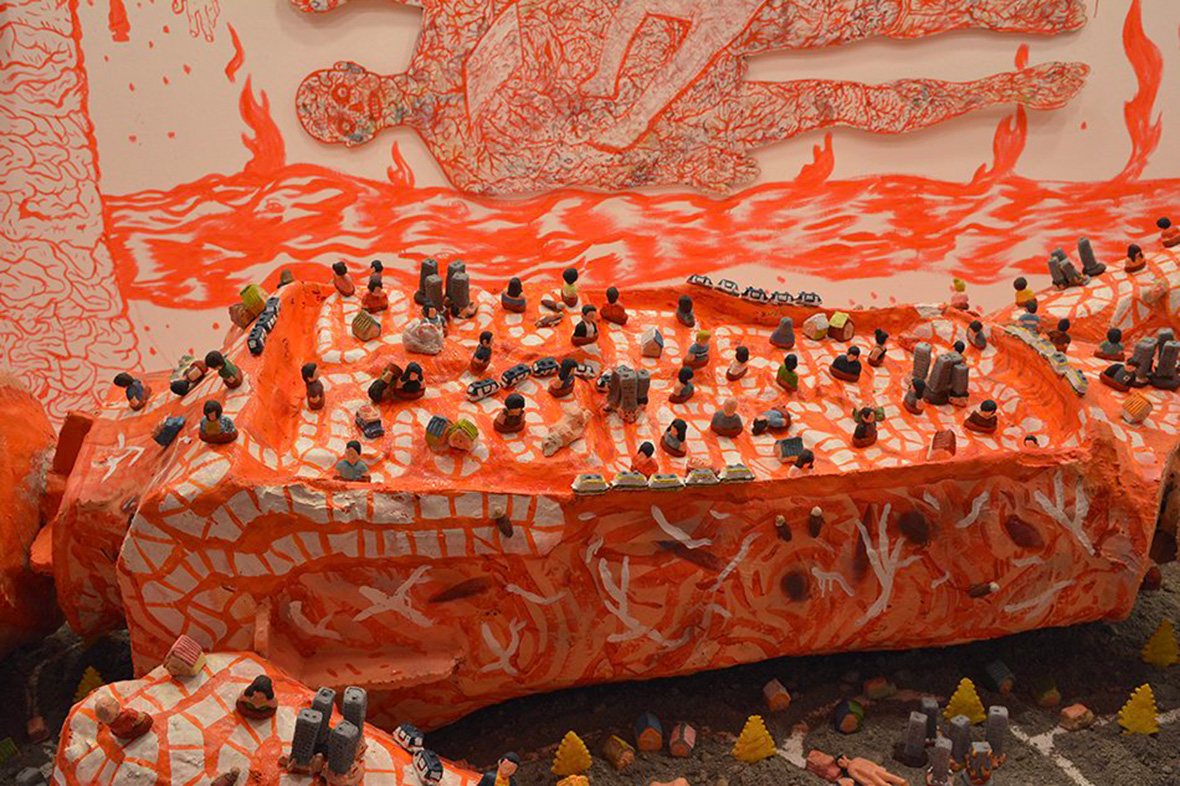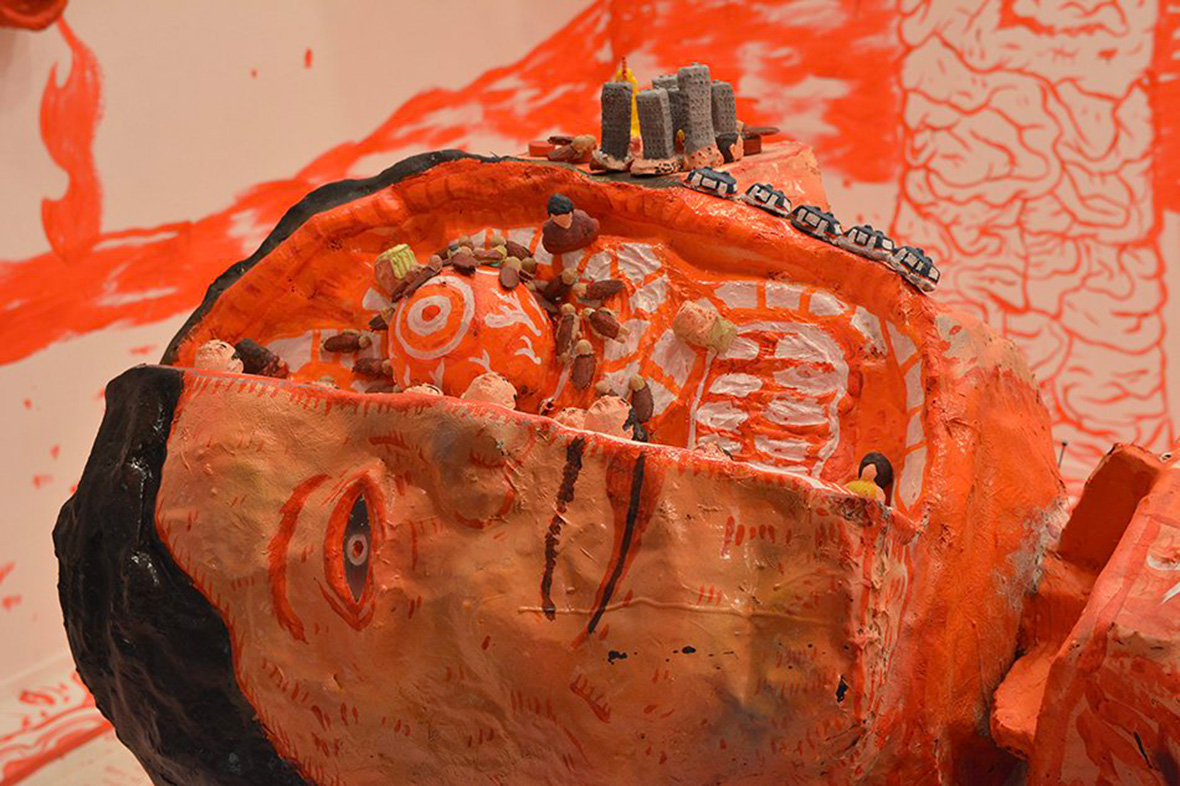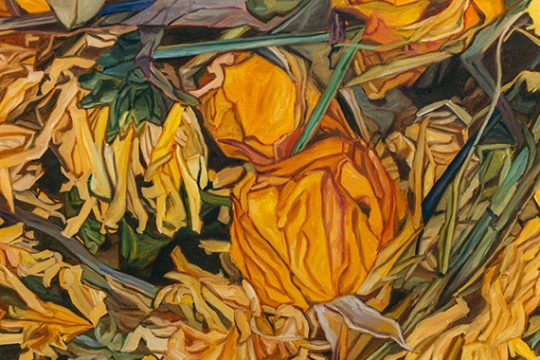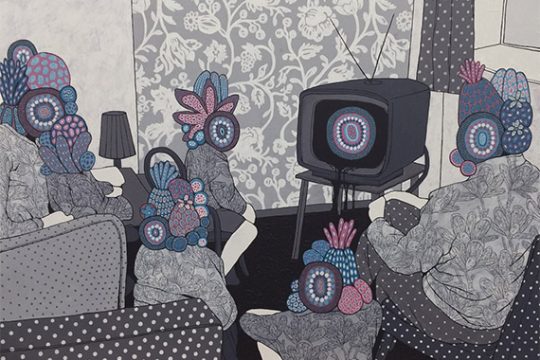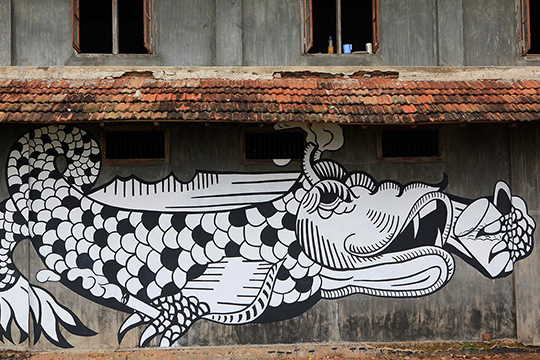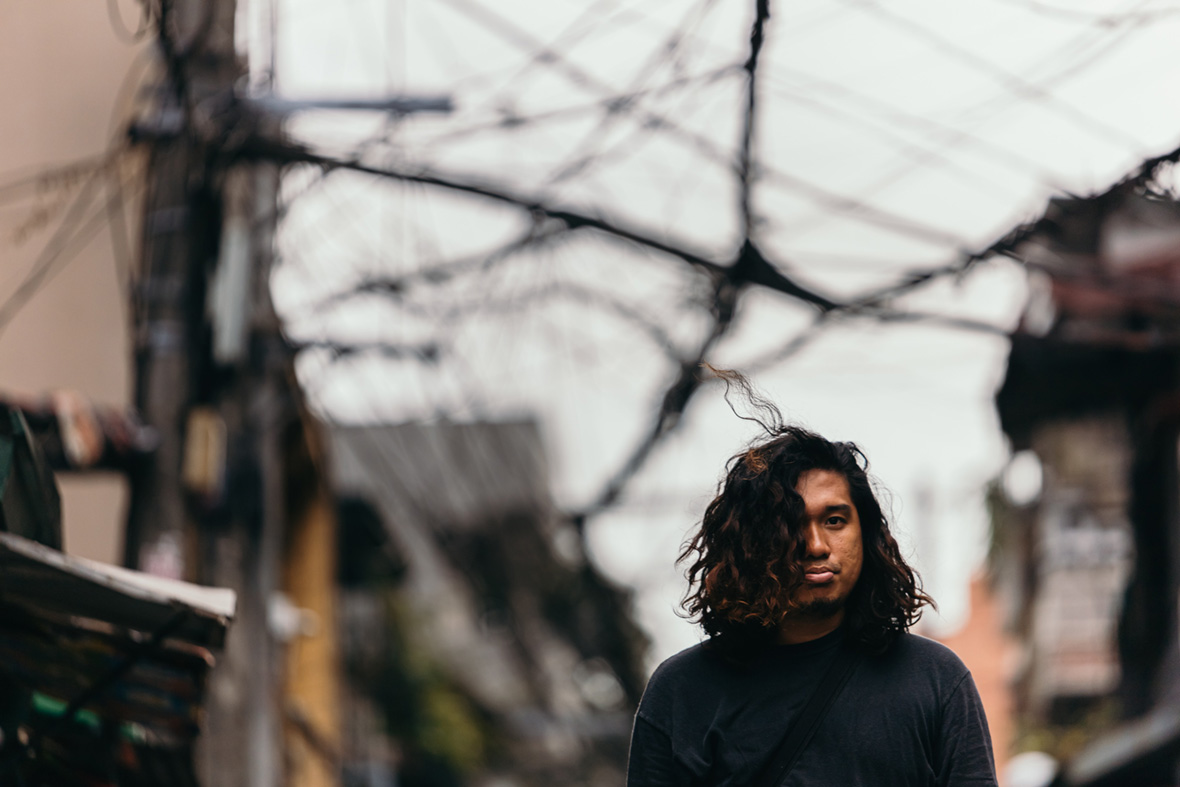
It’s no coincidence that the work of Doktor Karayom, the alias of multimedia artist Rasel Trinidad, is all done in blood red. As a fan of horror and gore, his crimson-tinged paintings and sculptures are rife with monsters and amputated body parts. But it’s never meant to shock or disgust—everything is all in good fun and done with a tongue-in-cheek playfulness.
多媒体艺术家 Doktor Karayom(别名 Rasel Trinidad)的作品都是血红色的。而这并非巧合。作为恐怖血腥的爱好者,他笔下赤调的绘画和雕塑充斥着怪物和被截肢的器官。但这绝不是为了使人惊吓或恶心—— Doktor Karayom 的作品充满趣味,而且是以嘲讽的方式呈现出来。
His recent multi-room mural, Hindi Totoo, which in Tagalog means “not real,” is like a comic artist’s fever dream. Creatures and victims writhe in pleasure and agony across every surface possible. The walls, ceiling, and stairs are covered with screaming faces and flames stretch across the ceiling. With each new floor and corner, the mural evolves and transforms.
他最近的多室墙绘《Hindi Totoo》,在“他加禄语”中的意思是“不真实的”,就像一个漫画艺术家的狂热梦想。画里的生物和被迫害的人在每个层面上都极尽痛苦地扭动着。被尖叫的脸庞覆盖着整个地面和楼梯,火焰在天花板上蔓延……每一层新地板和新角落,墙上的画面都在不断演变。
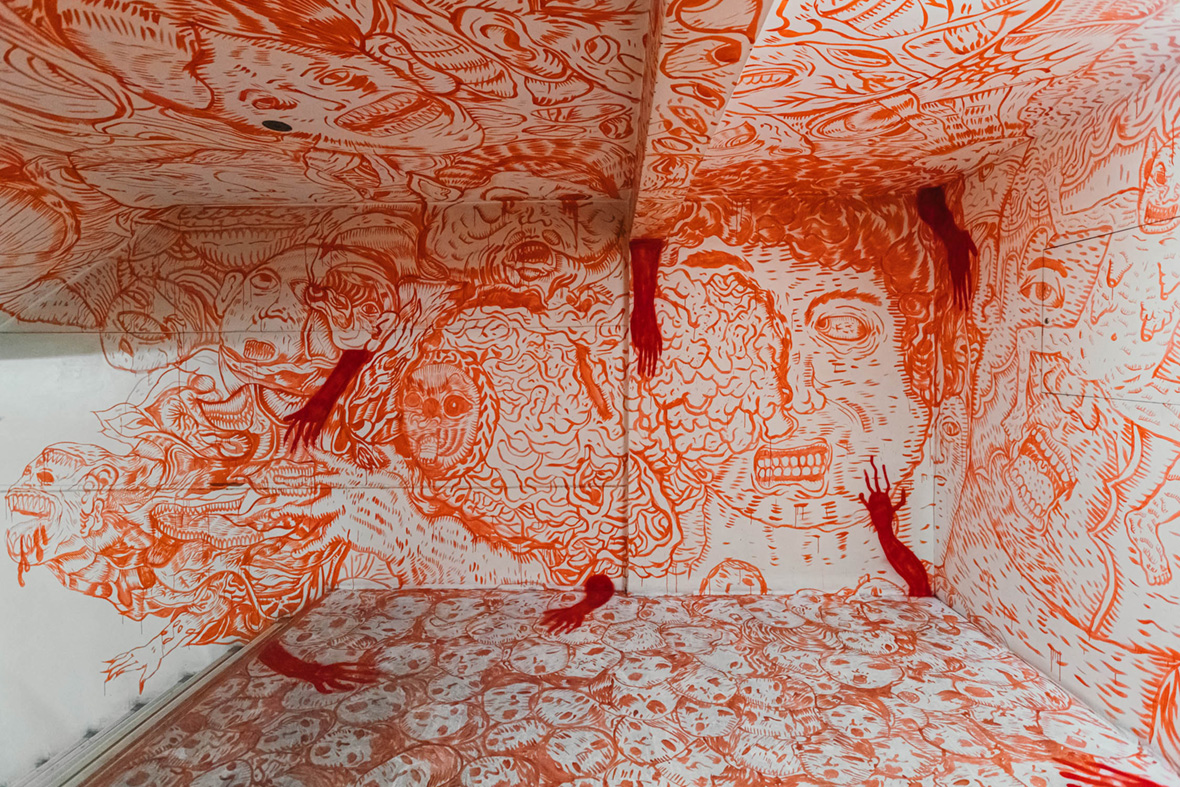
Many of the characters that appear in the piece are taken from Filipino folklore. You can find the tikbalang, which has the head of a horse with a human body, and aswangs, a term for various shape-shifting beings of legend. Inspiration also came from “Magandang Gabi Bayan,” a news segment he watched as a kid in the 90s. “They had Halloween specials where they told scary stories,” says Karayom. “These stories helped my imagination run free.”
许多出现在 Doktor Karayom 作品中的人物形象,都是从菲律宾民间传说中选出来的。你可以找到马头人身的提巴郎(tikbalang)和变形怪阿斯旺斯(aswangs)。一部分的灵感也来自于“马格丹加比巴扬”(Magandang Gabi Bayan),这是在上世纪 90 年代一个新闻节目里会定期播放的特殊栏目。“他们万圣节会讲恐怖故事,这些故事让我的想象力自由驰骋。”
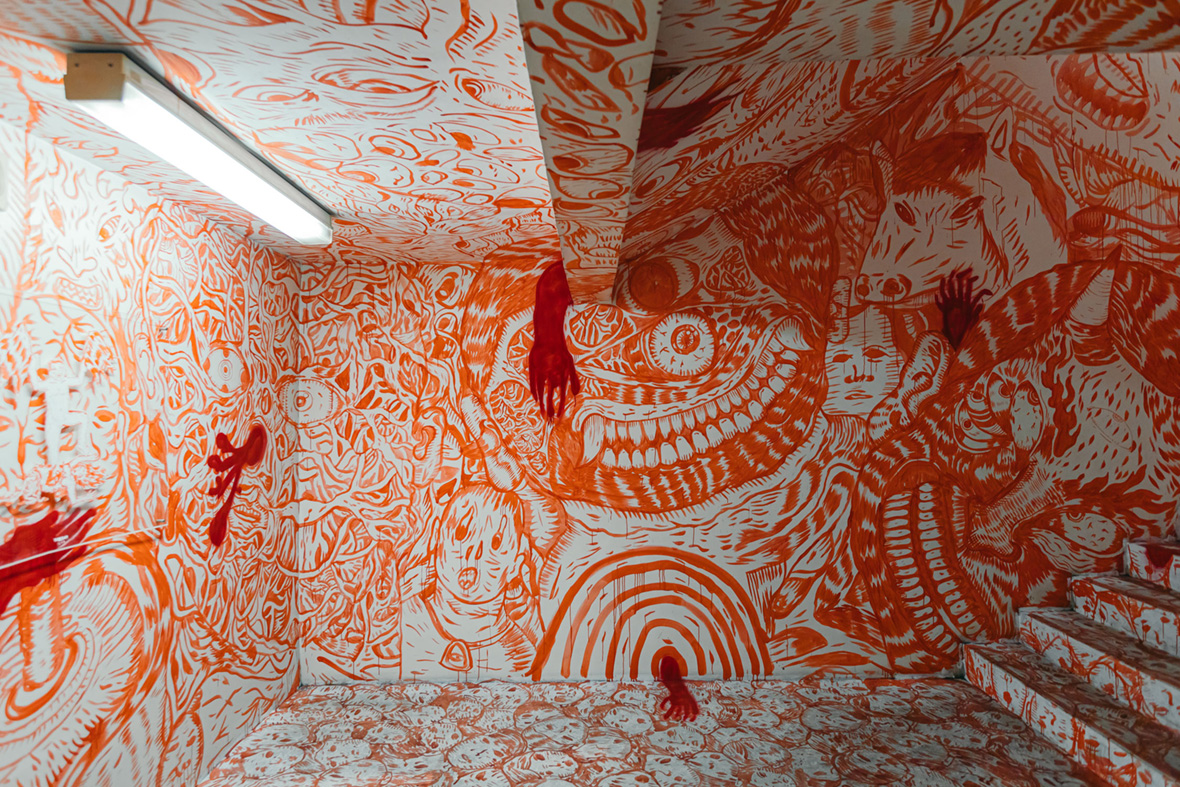
Hindi Totoo was done at Manila’s De La Salle-College of Saint Benilde, a school where many of the country’s creatives gravitate—if they can afford it. Karayom certainly couldn’t. “When I was a little kid I drew anything I saw, but I never thought I’d be an artist,” he recalls. “I wasn’t sure if I’d go to college, because we couldn’t afford tuition.” In any case, art hardly seemed worth studying to his family. “Since this is a third-world country, they wanted me to become a lawyer or doctor. But I asked them to trust me, because this is what I wanted. And my parents supported me.”
He attended the Technological University of the Philippines where he studied fine arts, but it was his experimentations with street art that helped him find his voice as an artist. “Once I started painting strictly with red, I think that’s when people started to notice me,” he recalls.
《Hindi Totoo》这系列是在马尼拉圣贝尼尔德的德拉萨学院创作的,那里是菲律宾许多创意家所吸引的学校(只要他们负担得起学费的话)。但显而易见的是,Doktor Karayom 并不能。他回忆说:“当我还是个小孩的时候,我会画画任何东西,但我从没想过会当艺术家。我不确定我是否会上大学,因为我们负担不起学费。”对他的家人来说艺术似乎都不值得研究。“这还是第三世界国家,他们希望我成为一名律师或医生。但是我要求他们信任我,因为这(艺术)就是我想要的。我的父母最后也很支持我。”
Doktor Karayom 进入了菲律宾科技大学就读美术。在那里,他学习了不同的艺术技巧和风格,但是他对街头艺术的尝试才让他找到了使命所在。“始终用红色绘画,我认为那是人们开始注意到我的时候。”他回忆道。
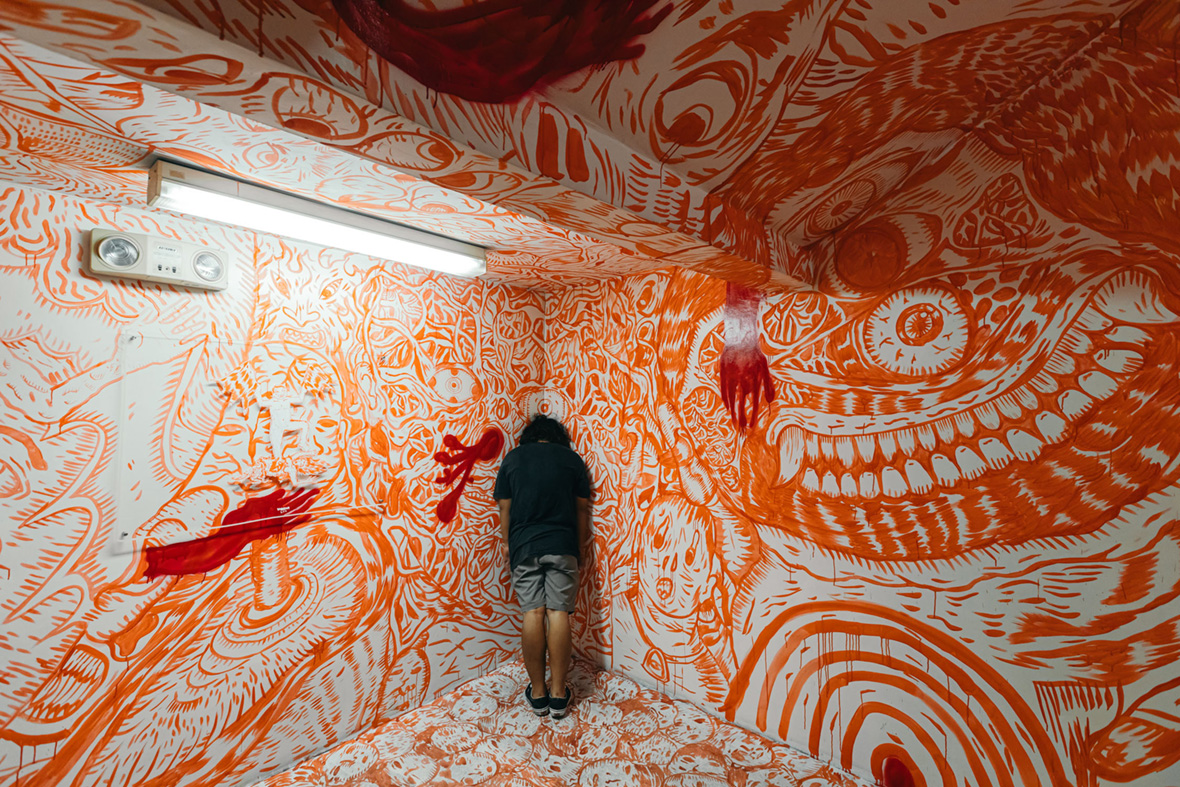
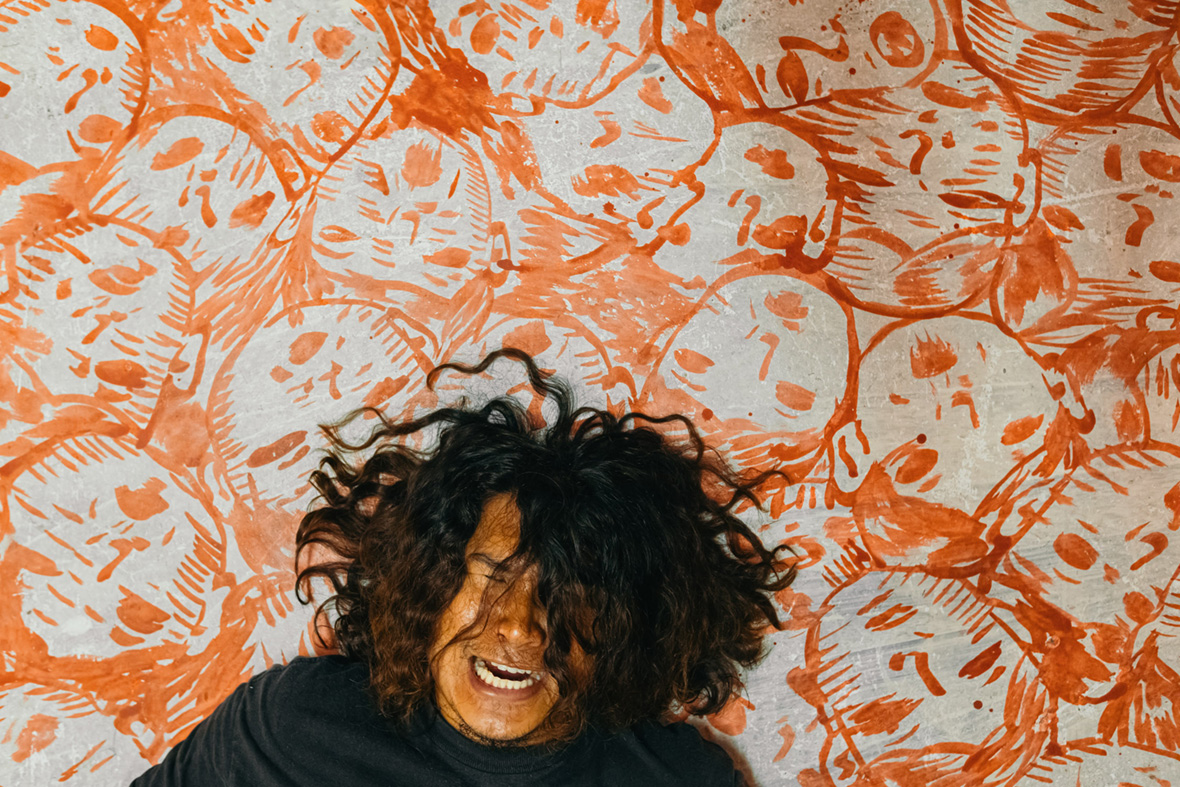
After graduation, Karayom worked an office job doing graphic design for a few years. While there, he often stole supplies and secretly worked on his own art on the clock. “I was working in the office still, splitting my corporate and artistic mind. So I let myself go and just did what I wanted,” he laughs. “At work I was creating small sculptures under the table, hiding my paints and clay in the desk drawer.”
This insistence on pursuing his own art paid off, and now Karayom is a full-time artist with a number of national awards under his belt. In 2018, he was a recipient of a CCP 13 Artist Award (alongside Archie Oclos, who we covered earlier last year). His stairwell mural at La Salle was part of the exhibit that came along with the award. It took him two weeks to finish, painting twelve hours a day, every day. He was also a part of a group show at the renowned Parisian gallery Palais de Tokyo this year, where he painted as many surfaces as they allowed.
毕业后,Doktor Karayom 有几年坐班工作,从事平面设计。在那里,他经常在上班时间用公司设备和材料偷偷地进行自己的艺术创作。“我仍然在办公室工作,工作和艺术分部进行。所以后来我就放任自己去做我想做的事了。”他大笑道,“工作时,我在桌子下面创作小雕塑,把我的颜料和粘土都藏在抽屉里。”
这种坚持最终得到了回报。现在的 Doktor Karayom 已是一名全职艺术家,拥有多项国家奖项。2018 年,他获得了 CCP 13 艺术家奖 (与我们在去年早些时候报道的 Archie Oclos 一并获奖)。他在德拉萨学院的墙绘是与该奖项同期展览的一部分。他花了两个星期的时间才画完,每天 12 个小时。他也是今年在著名的巴黎画廊东京宫举办的群展的一部分。
For both shows, one of the most striking works was a life-sized sculpture of José Rizal, a Filipino nationalist who helped inspire a rebellion against Spanish colonists in the late 19th century. Rizal’s story didn’t end on a happy note—he was executed by the Spanish—but his role in helping the country gain its independence has nevertheless made him a beloved national hero.
Karayom’s depiction of Rizal doesn’t quite paint him in a heroic light, however. As in his other macabre works, he opts to show Rizal as a corpse in partial decay, with miniature figures devouring him. He’s not keen on revealing what he thinks it means: he enjoys leaving everything open for interpretation, believing that it’s important for the audience to discover their own meaning in art. “What you see is up to you,” he says with a mischievous grin.
在这两场展览中,最引人注目的作品之一是一个真人大小的 José Rizal 的雕塑,这是位菲律宾民族主义者,在 19 世纪末倡导人们反抗西班牙殖民。José Rizal 的故事并没有愉快的结局,但他在帮助国家获得独立方面所发挥的作用,却使他成为深受爱戴的民族英雄。
可 Doktor Karayom 对 José Rizal 却并没有把他以很光荣的形式呈现。和 Doktor Karayom 的其他作品一样恐怖,他选择将 José Rizal 展示为一具半腐朽的卧尸,微型的小人啃啮着他。Doktor Karayom 并不热衷于揭示其背后的含义,他喜欢让观众自行理解,观众发现自己的艺术意义很重要。“你所看到的取决于你。”他带着狡黠的笑容说。
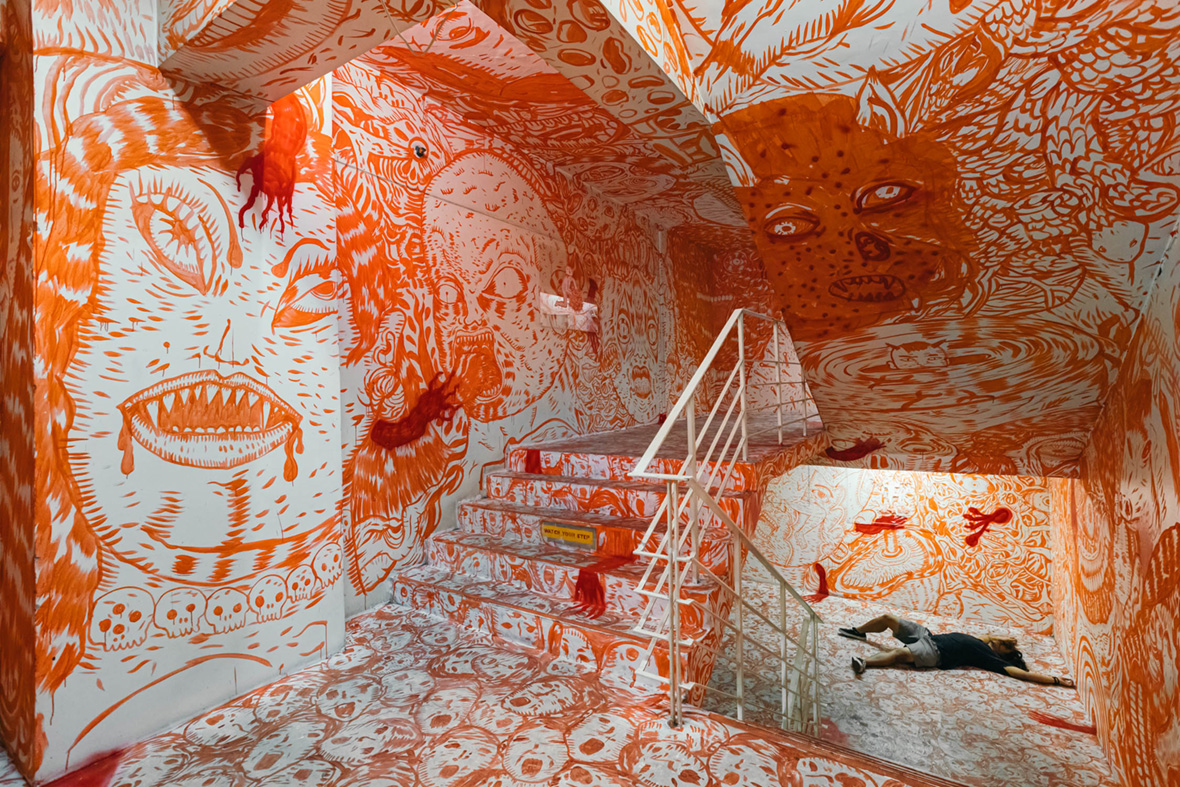
Like our stories? Follow us on Facebook and Instagram.
Instagram: @doktorkarayom
Contributor: Mike Steyels
Photographer: Jilson Tiu
Chinese Translation: Chen Yuan


